$XOM $CVX $USO $COP $IMO
#OilMarket #OPEC #EnergySector #ElectricVehicles #EnergyEfficiency #OilPrices #NonOPEC #OilDemand #OilSupply #GlobalEnergy #InvestingInOil #SustainableEnergy
Bloomberg Opinion columnist Javier Blas offers a forward-looking perspective on the dynamics of the oil market leading into 2025, providing insight into the interplay of supply, demand, and price. According to Blas, the oil industry is on the cusp of a significant change. He points out that while the current oil prices seem to reflect a weakness in demand, this isn’t entirely accurate. Contrary to what the prices suggest, oil demand continues to grow at about 1 million barrels per day. This growth is sustained despite two significant trends: the rapid increase in the adoption of electric vehicles and the continuous improvement in the energy efficiency of consumer appliances which, in theory, could dampen oil consumption.
Blas highlights a forthcoming shift that could potentially reshape the global oil market: an oversupply in 2025. This prediction stems from a combination of factors, including the unwinding of production cuts by the Organization of the Petroleum Exporting Countries (OPEC) and a surge in supply from non-OPEC countries, notably the United States, Canada, and Guyana. These developments suggest that while the demand for oil remains robust for the time being, the supply side is gearing up for significant expansion. Such an imbalance between supply and demand could have wide-reaching implications for the market, potentially leading to lower prices unless demand surges unexpectedly.
The analysis reflects on the complex and often unexpected interconnections between oil supply, demand, and technological advancements in the energy sector. The rapid adoption of electric vehicles (EVs) is a prime example of a factor that could considerably impact oil demand. However, as Blas notes, the effect of EVs on oil demand is currently offset by general demand growth in other sectors and geographies. This nuanced view underscores the importance of looking beyond single factors or trends when assessing the future of the oil market.
Furthermore, Blas’s commentary provides valuable insights for investors, policymakers, and stakeholders in the energy sector. By signaling a potential future oversupply, he prompts considerations around strategic investments, energy policies, and the global push towards more sustainable energy sources. As the market moves towards the forecasted scenario, stakeholders will need to navigate the implications of shifting supply-and-demand dynamics, technology advancements, and environmental considerations. This evolving landscape offers both challenges and opportunities—requiring careful analysis and strategic planning for those involved in or affected by the global energy markets.







Comments are closed.